Central Vacuum Buyer’s Guide
Make an informative purchasing decision.
Filtration
Your central vacuum system is more than just a vacuum providing superior suction and cleaning. It’s a built-in appliance that you should have for many years of trouble free service.
Choosing a system with long motor longevity is the key to a trouble free system that will last a long time. But what about maintenance? Like most of us, once installed the central vacuum has been installed out of sight in your garage, basement or utility room, it is an appliance that we forget about.
The only time you might think of your central vacuum system is when you experience a loss in suction which usually means that the dirt canister needs to be emptied or the bag replaced.
However, some systems require maintenance beyond just seasonal emptying to ensure that the system operates at optimal performance.
At Cana-Vac, we believe that the best central vacuum systems should be maintenance free and continue to perform for years of uninterrupted service, after all, who wants the messy task of cleaning or replacing a dirty (and contaminated) filter?
One of the considerations of the central vacuum system you choose should be how easy is it to maintain?
If the unit requires replacing or cleaning filters, you might consider an alternate filtration method, one that does not require maintenance. All the nasty things you vacuum such as bacteria, dust mites, pollens, pet dander are all contained in your central vacuum canister and on the filter…the last thing you want is to have to come in contact with these things.
Cana-Vac’s zero maintenance approach works so you don’t have to ever come in contact with these harmful contaminants.
Why do central vacuums need filters if the can be vented outdoors?
The primary function of the filter is to protect the motor from damaging fine dust particles, even the best non-filter cyclonic systems allow fine dust to blow through the motor shortening life expectancy.
The other benefit to having a filter installed in your central vacuum is that if the filter is efficient enough, such as an anti-allergen filter like a HEPA, it allows the ventilation of the central vacuum exhaust indoor or in a place such as a garage without leaving dust all over. Of course the true benefit to any central vacuum is venting outside your living space which is why central vacuums have been clinically proven to reduce allergy symptoms!
Cana-Vac uses a “Hybrid” approach to filtration that is becoming increasingly popular among manufacturers since it offers a bag or bagless solution. A Hybrid allows you to choose the convenience and cleanliness of an Allergen Bag or if you prefer, use a unit without bag option because it’s fitted with a secondary filter.
Cana-Vac uses the Maintenance optional filter in Ethös models and the premium HEPA Membrane Maintenance Free filter in Signature™ series models.
This filtration is also commonly referred to as inverted bag or a self-cleaning filter – although, this isn’t entirely accurate. It’s referred to as self-cleaning because when the unit is running, the bag inverts with the suction of the motor upwards. When the unit is shut off, the bag drops towards the dirt pail and any excess dust falls into the dirt canister. This type of filtration method flexes up and down.
Filtration Efficiency
The illustration on the right shows microscopic images of two filters. You’ll notice that the filtration in the first illustration captures a much finer particle versus the image lower right which is not as efficient. The higher the efficiency in relation to particle size tells us what percentage of particles is filtered. For example, a .1 Micron filter at 95% efficiency means that 95% of particles at a .1 micron size are captured and the remaining 5% pass through the filter. A .1 micron at 99% means that particles of .1 micron in size are captured and 1% passes through the filter.
Why is this important? The more efficient the filter the more protection it offers to both the motor and your living environment. If the unit is vented outside your living space filtration may not be as important as if you were installing the unit in a basement or utility room where the unit vents indoors.
Central Vacuum Filtration Types:
Foam Filtration: This is the least desirable but cheapest option. Typically, this type of filter may also use a Cyclonic action to remove most debris from the air stream to prevent clogging the filter. The small particles not separated cyclonically are captured by the foam filter.
As the filter loads with dirt, Airflow diminishes and the unpleasant task of removing and washing this filter is required or at some point, replaced. As a result, Cana-Vac rates this type of filtration the least desirable with a rating of 1 out of 5 stars.
Cartridge Filtration: This is a superior option compared to a standard foam filter and should have better Airflow performance.
Like its foam counterpart, it may rely on the cyclonic action to filter most particles from the airstream with the finer particles captured by the Cartridge. This filter must be either washed or replaced. It involves reaching inside a contaminated, dirty central vacuum unit to remove and perform maintenance. Cana-Vac rates this filter type at 2 out of 5 stars.
Semi-Cyclonic (Filter Cyclonic) systems may advertise they are cyclonic but actually implement the use of a foam or cartridge filter (as shown in the illustration on the left). The cyclonic action in this type of unit is designed to separate as much debris from the air stream while the foam or cartridge filter prevents fine particles from entering the motor. In this instance, the increased Airflow performance of a true cyclonic system is negated because a secondary filter is used.
Cyclonic systems with secondary filters still require that the filter be replaced or washed to maintain optimal performance. While this option is better than using cartridge or foam filter only, the fact that the consumer has the unpleasant task of messy maintenance is a deterrent. However, the cyclonic separation means potentially less frequent times between maintenance so we’d give this method of filtration 3 out of 5 stars.
True Cyclonic: Few manufacturers actually produce true “cyclonic only” systems which should say something about the importance of filtration within a central vacuum system.
True Cyclonic systems do not use filters and rely exclusively on the cyclonic action to separate the dirt. Since they offer the least amount of motor protection, more dirt passes through the motor and must be exhausted outdoors. However, despite not having secondary filtration, this doesn’t mean that this type of unit doesn’t require any maintenance.
Inside the unit, there’s a protective screen to prevent larger particles not separated by the cyclonic action from entering the motor. Eventually carpet fibers, hair, or anything not separated by the cyclonic action collects on the protective screen reducing Airflow.
Just like the previous filter types, maintenance involves reaching up inside the dirty unit and cleaning the protective screen when you experience a reduction in Airflow.
When the protective screen is clean however, a True cyclonic system will offer the best Airflow of any filter method. However, these systems also provide the least amount of protection for the motor.
Since this type of filtration still would expose you to potential vacuum contaminants when performing maintenance combined with the fact that it must be vented outdoors, Cana-Vac rates this filtration type at 3 out of 5 stars but would give it the best rating for performance.
Allergen Bag Filtration: Paper bag technology has come a long way from the bags of years past that were dirty and prone to tearing. For the purpose of this summary, Cana-Vac refers to the new cloth-like, multi-layer paper bags that capture most allergens and pollutants. This means that even when full, the bag remains clean on the outside minimizing any contact with the nasty things vacuumed.
Unlike systems that use other filtration types, you’re not exposed to the contaminated dust plume when you empty the dirt canister.
This is the cleanest of all filtration types. When the bag is replaced, you’re starting with a fresh and new filter.
Every Cana-Vac Signature™ unit comes standard equipped with a free 3-Pack of Allergen Bags.
Since exposure to vacuumed contaminants is minimized with this system and aside from replacing the bag, no maintenance is required; Cana-Vac rates this type of filtration 5 out of 5 stars.
Maintenance Optional Filtration
Sometimes referred to as “Inverted Bag” or “Self-Cleaning” filtration, this type of filter flexes upward and downward as the central vacuum turns on and off. Cana-Vac believes that the term “self-cleaning” is somewhat misleading. This filter does not actually “clean” itself, however unlike other filtration methods, the excess dirt which may cling to the fitler is shaken off due to the upward and downward movement of the filter as excess dirt cake collects on the filter surface.
Dirt cake on this filter is normal and actually increases filtration efficiency albeit at the expense of some airflow.
Maintenance is not mandatory with this filter type. However, should you wish to perform maintenance on this filter, you will not come in contact with contaminants. Simply wrap a garbage bag tightly around the unit and then, using the garbage bag, reach up inside and giving the filter a shake. Wait a few moments and remove the garbage bag.
These filters are permanent and last the life of the system. Although, you should check with the manufacturer’s owner’s manual to be sure.
This is one of the most commonly used filtration methods. Since it does not require mandatory maintenance while at the same time, offering good filtration, Cana-Vac rates this type of filtration 4 out of 5 stars.
HEPA Membrane Filtration
Like its cousin the maintenance-optional filter, this filter type is actually maintenance free because it’s treated with a non-stick surface.
This is the preferred choice for those who want a bagless option.
Cana-Vac Signature™ models use these high efficiency HEPA membrane filters. They’re coated with a non-stick coating that prevents dirt cake from adhering to the filter.
Since the material is a HEPA membrane, this filter has a performance rating to effectively capture 99.97% of particles of .3 micron size (the size of most bacteria).
Micron reference:
Pollens: 10 to 1000 microns
Human Hair: 40 to 300 microns
Mold Spores: 10 to 30 microns
Be aware that the color of a filter does not indicate what type of filter is being used. Ask the sales person or refer to the product brochure for full product details.
Since this filter does not require any maintenance and offers the best filtration, Cana-Vac rates this filtration type 5 out of 5 stars.
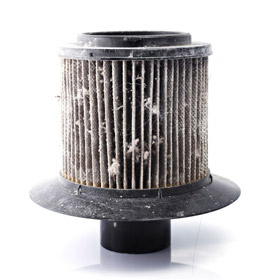

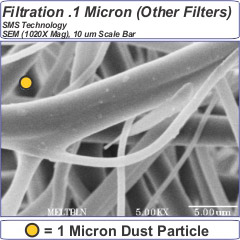
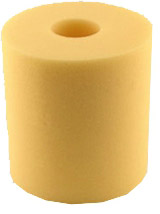


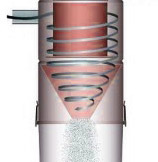
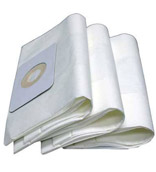
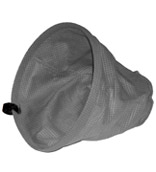

Your central vacuum system is more than just a vacuum providing superior suction and cleaning. It’s a built-in appliance that you should have for many years of trouble free service.
Choosing a system with long motor longevity is the key to a trouble free system that will last a long time. But what about maintenance? Like most of us, once installed the central vacuum has been installed out of sight in your garage, basement or utility room, it is an appliance that we forget about.
The only time you might think of your central vacuum system is when you experience a loss in suction which usually means that the dirt canister needs to be emptied or the bag replaced.

However, some systems require maintenance beyond just seasonal emptying to ensure that the system operates at optimal performance.
At Cana-Vac, we believe that the best central vacuum systems should be maintenance free and continue to perform for years of uninterrupted service, after all, who wants the messy task of cleaning or replacing a dirty (and contaminated) filter?
One of the considerations of the central vacuum system you choose should be how easy is it to maintain?

If the unit requires replacing or cleaning filters, you might consider an alternate filtration method, one that does not require maintenance. All the nasty things you vacuum such as bacteria, dust mites, pollens, pet dander are all contained in your central vacuum canister and on the filter…the last thing you want is to have to come in contact with these things.
Cana-Vac’s zero maintenance approach works so you don’t have to ever come in contact with these harmful contaminants.
Why do central vacuums need filters if the can be vented outdoors?
The primary function of the filter is to protect the motor from damaging fine dust particles, even the best non-filter cyclonic systems allow fine dust to blow through the motor shortening life expectancy.
The other benefit to having a filter installed in your central vacuum is that if the filter is efficient enough, such as an anti-allergen filter like a HEPA, it allows the ventilation of the central vacuum exhaust indoor or in a place such as a garage without leaving dust all over. Of course the true benefit to any central vacuum is venting outside your living space which is why central vacuums have been clinically proven to reduce allergy symptoms!
Cana-Vac uses a “Hybrid” approach to filtration that is becoming increasingly popular among manufacturers since it offers a bag or bagless solution. A Hybrid allows you to choose the convenience and cleanliness of an Allergen Bag or if you prefer, use a unit without bag option because it’s fitted with a secondary filter.
Cana-Vac uses the Maintenance optional filter in Ethös models and the premium HEPA Membrane Maintenance Free filter in Signature™ series models.

This filtration is also commonly referred to as inverted bag or a self-cleaning filter – although, this isn’t entirely accurate. It’s referred to as self-cleaning because when the unit is running, the bag inverts with the suction of the motor upwards. When the unit is shut off, the bag drops towards the dirt pail and any excess dust falls into the dirt canister. This type of filtration method flexes up and down.
Filtration Efficiency
The illustration on the right shows microscopic images of two filters. You’ll notice that the filtration in the first illustration captures a much finer particle versus the image lower right which is not as efficient. The higher the efficiency in relation to particle size tells us what percentage of particles is filtered. For example, a .1 Micron filter at 95% efficiency means that 95% of particles at a .1 micron size are captured and the remaining 5% pass through the filter. A .1 micron at 99% means that particles of .1 micron in size are captured and 1% passes through the filter.
Why is this important? The more efficient the filter the more protection it offers to both the motor and your living environment. If the unit is vented outside your living space filtration may not be as important as if you were installing the unit in a basement or utility room where the unit vents indoors.
Central Vacuum Filtration Types:
Foam Filtration: This is the least desirable but cheapest option. Typically, this type of filter may also use a Cyclonic action to remove most debris from the air stream to prevent clogging the filter. The small particles not separated cyclonically are captured by the foam filter.

As the filter loads with dirt, Airflow diminishes and the unpleasant task of removing and washing this filter is required or at some point, replaced. As a result, Cana-Vac rates this type of filtration the least desirable with a rating of 1 out of 5 stars.
Cartridge Filtration: This is a superior option compared to a standard foam filter and should have better Airflow performance.
Like its foam counterpart, it may rely on the cyclonic action to filter most particles from the airstream with the finer particles captured by the Cartridge. This filter must be either washed or replaced. It involves reaching inside a contaminated, dirty central vacuum unit to remove and perform maintenance. Cana-Vac rates this filter type at 2 out of 5 stars.

Semi-Cyclonic (Filter Cyclonic) systems may advertise they are cyclonic but actually implement the use of a foam or cartridge filter (as shown in the illustration on the left). The cyclonic action in this type of unit is designed to separate as much debris from the air stream while the foam or cartridge filter prevents fine particles from entering the motor. In this instance, the increased Airflow performance of a true cyclonic system is negated because a secondary filter is used.

Cyclonic systems with secondary filters still require that the filter be replaced or washed to maintain optimal performance. While this option is better than using cartridge or foam filter only, the fact that the consumer has the unpleasant task of messy maintenance is a deterrent. However, the cyclonic separation means potentially less frequent times between maintenance so we’d give this method of filtration 3 out of 5 stars.
True Cyclonic: Few manufacturers actually produce true “cyclonic only” systems which should say something about the importance of filtration within a central vacuum system.
True Cyclonic systems do not use filters and rely exclusively on the cyclonic action to separate the dirt. Since they offer the least amount of motor protection, more dirt passes through the motor and must be exhausted outdoors. However, despite not having secondary filtration, this doesn’t mean that this type of unit doesn’t require any maintenance.
Inside the unit, there’s a protective screen to prevent larger particles not separated by the cyclonic action from entering the motor. Eventually carpet fibers, hair, or anything not separated by the cyclonic action collects on the protective screen reducing Airflow.

Just like the previous filter types, maintenance involves reaching up inside the dirty unit and cleaning the protective screen when you experience a reduction in Airflow.
When the protective screen is clean however, a True cyclonic system will offer the best Airflow of any filter method. However, these systems also provide the least amount of protection for the motor.
Since this type of filtration still would expose you to potential vacuum contaminants when performing maintenance combined with the fact that it must be vented outdoors, Cana-Vac rates this filtration type at 3 out of 5 stars but would give it the best rating for performance.
Allergen Bag Filtration: Paper bag technology has come a long way from the bags of years past that were dirty and prone to tearing. For the purpose of this summary, Cana-Vac refers to the new cloth-like, multi-layer paper bags that capture most allergens and pollutants. This means that even when full, the bag remains clean on the outside minimizing any contact with the nasty things vacuumed.
Unlike systems that use other filtration types, you’re not exposed to the contaminated dust plume when you empty the dirt canister.
This is the cleanest of all filtration types. When the bag is replaced, you’re starting with a fresh and new filter.
Every Cana-Vac Signature™ unit comes standard equipped with a free 3-Pack of Allergen Bags.

Since exposure to vacuumed contaminants is minimized with this system and aside from replacing the bag, no maintenance is required; Cana-Vac rates this type of filtration 5 out of 5 stars.
Maintenance Optional Filtration
Sometimes referred to as “Inverted Bag” or “Self-Cleaning” filtration, this type of filter flexes upward and downward as the central vacuum turns on and off. Cana-Vac believes that the term “self-cleaning” is somewhat misleading. This filter does not actually “clean” itself, however unlike other filtration methods, the excess dirt which may cling to the fitler is shaken off due to the upward and downward movement of the filter as excess dirt cake collects on the filter surface.
Dirt cake on this filter is normal and actually increases filtration efficiency albeit at the expense of some airflow.
Maintenance is not mandatory with this filter type. However, should you wish to perform maintenance on this filter, you will not come in contact with contaminants. Simply wrap a garbage bag tightly around the unit and then, using the garbage bag, reach up inside and giving the filter a shake. Wait a few moments and remove the garbage bag.
These filters are permanent and last the life of the system. Although, you should check with the manufacturer’s owner’s manual to be sure.
This is one of the most commonly used filtration methods. Since it does not require mandatory maintenance while at the same time, offering good filtration, Cana-Vac rates this type of filtration 4 out of 5 stars.

HEPA Membrane Filtration
Like its cousin the maintenance-optional filter, this filter type is actually maintenance free because it’s treated with a non-stick surface.
This is the preferred choice for those who want a bagless option.
Cana-Vac Signature™ models use these high efficiency HEPA membrane filters. They’re coated with a non-stick coating that prevents dirt cake from adhering to the filter.
Since the material is a HEPA membrane, this filter has a performance rating to effectively capture 99.97% of particles of .3 micron size (the size of most bacteria).
Micron reference:
Pollens: 10 to 1000 microns
Human Hair: 40 to 300 microns
Mold Spores: 10 to 30 microns
Be aware that the color of a filter does not indicate what type of filter is being used. Ask the sales person or refer to the product brochure for full product details.
Since this filter does not require any maintenance and offers the best filtration, Cana-Vac rates this filtration type 5 out of 5 stars.


Useful links
Privacy statement | Copyright | Cookie policy | Social network
Contact Data
Phone: +40 735 705 507
E-mail: office@canavac.eu
Program: 09:00 – 17:00 (Mon - Fri)
Address: 284 Mamaia Boulevard
Constanța, Constanța county, 900552

